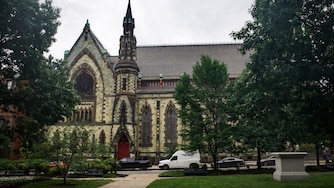Ten years ago, I stood beside a grieving family and an outraged city. Freddie Carlos Gray Jr. was 25 years old, and just like me, Black, Baltimore-born and bred. But unlike me, Freddie hadn’t lived long enough to escape what too many call “the wrong side of the tracks.”
On this fateful day, he had committed no crime. He posed no threat. And yet he was chased, cuffed, thrown in a police van, and driven to his death, suffering a fatal spinal injury in the back of that van.
I will never forget that day, nor what it revealed to the world about the conditions we in Baltimore had long endured. In so many ways, Freddie’s demise was avoidable yet inevitable at the same damn time.
What happened to Freddie wasn’t a glitch in the system — it was the system working exactly how it was designed. For Black communities, overpolicing and under-protection is a way of life. Freddie didn’t die just because of six officers. He died because of decades of policies and practices that devalued Black life — because of the housing segregation that hemmed him in, the schools that failed him, the lead in the walls that poisoned his potential and the economic disinvestment that left him few paths forward.
Freddie’s death sparked a rebellion in Baltimore. Not a riot. A rebellion. This uprising wasn’t senseless. It was righteous, predictable and necessary. It was mostly young people, poor people, forgotten people — all screaming: enough. The world finally saw what we had been yelling about for years in Baltimore and in every city where Black lives don’t matter enough.
In the days that followed, my firm worked hard to provide comfort to the Gray family and to raise the temperature on then-Attorney General Loretta Lynch, to take a hard look at the Baltimore Police Department. This needed to be a pivotal moment in the national reckoning with systemic police violence. At a time when public trust in law enforcement — especially in Black communities — was deeply fractured, the federal government could no longer ignore patterns of abuse, misconduct and unconstitutional policing.
Action from Lynch and the Obama administration would bring legitimacy to the community’s demands for accountability and highlight the necessity of structural reform in departments plagued by racial profiling, excessive force and a culture of corruption. It was a clear message that fixing policing in America required more than small adjustments at the margins; it needed comprehensive institutional reform.
Leading the charge for reform and accountability was Marilyn Mosby. As Baltimore’s state’s attorney, she chose to prosecute the six officers involved. It was a bold move — a rare example of a prosecutor standing up to police power, and standing with the people. Her decision was not without controversy, and the cases ultimately ended in acquittals or dropped charges.
But history will remember her courage, and her enduring legacy is the advent of police-worn body cameras in Baltimore and throughout America. She said plainly what needed to be said: No one is above the law, including law enforcement. That mattered. That still matters. And it sent a signal, however imperfectly received, that this city was not afraid to confront its own demons with an intentionality not before seen until that moment.
In the decade since, some things have changed. The Department of Justice came to town and confirmed what many of us already knew: The Baltimore Police Department had a pattern and practice of unconstitutional behavior, especially toward Black communities. A consent decree followed. We’ve seen new leadership, new policies, a move — albeit hesitantly — toward transparency and community oversight. We’ve seen incredibly talented and committed young organizers and everyday citizens wanting a better, fairer city step up and lead. A lot has changed in Baltimore since 2015.
But let’s be honest: It’s not the city it needs to be. Not yet.
The Police Department is still under a federal microscope for a reason. Trust remains elusive. Too many of our schools are still crumbling, our neighborhoods still lacking, our children still caught between violence and neglect. We’ve had some political wins and some deep political failures. Too many folks in power still talk about justice like it’s a branding exercise instead of a moral obligation.
So, what would it mean to truly honor Freddie’s life, 10 years later?
It means building a Baltimore where we don’t just respond to injustice — we prevent it. It means supporting Mayor Brandon Scott’s doubling-down on our investments in communities that have only known neglect. It means reforming our police department not just in policy, but in culture, down to its DNA. It means making public safety a collective responsibility, not a Black issue. It means being intentional about resourcing community-rooted leaders and organizations and less deference to the white saviorism too often found in Baltimore’s nonprofit ethos.
In 10 years, I want to see a city closer to realizing its immense potential to be the jewel of the East Coast. A city where children can grow up healthy, housed and hopeful. A city where Black people are treated as stakeholders, not suspects.
We don’t honor Freddie Gray by naming a street after him. We honor him by making sure there are no more Freddie Grays.
This work is far from over. But it is not beyond us. Baltimore is a beautifully situated city, and we have the brilliance, the power and the will. And I, for one, am not done fighting.
William H. “Billy” Murphy is a civil rights attorney and founding partner at Murphy, Falcon & Murphy. He represented the family of Freddie Gray.



Comments
Welcome to The Banner's subscriber-only commenting community. Please review our community guidelines.